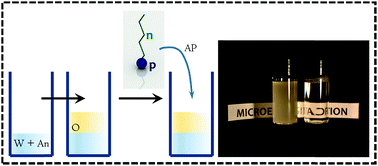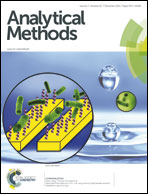Microemulsification-based method: analysis of ethanol in fermentation broth of sugar cane†
Abstract
This article addresses important results for the consolidation of the microemulsification-based method (MEC), an approach recently proposed by these authors, which represents a powerful output for the deployment of point-of-use technologies. In MEC, the detection is conducted in a solution with the naked eyes. It relies on the effect of the analyte on the formation of microemulsions (MEs). The minimum volume fraction of amphiphile needed to obtain ME (ΦME) is the analytical response whose measurement is based on binary chemical information: the cloudy-to-transparent transition that occurs with microemulsification. Accordingly, this signal can be precisely detected with the naked eye, thus enabling precise determinations. The experiments that were accomplished are as follows: robustness investigation and the direct determination of ethanol in fermentation broths of sugar cane. Dispersions were composed of water, oleic acid, and ethanol as hydrophilic (W), hydrophobic (O), and amphiphilic (AP) phases, respectively. Standards of analyte were added to the W phase before the addition of AP in the W–O mixture to attain the analytical curves. For application, the samples were directly used as the W phase. Our approach was somewhat robust with regard to deviations in volumetric preparation of the dispersions and changes in temperature and conductivity. Lastly, the reliability of the MEC was evaluated in the determination of ethanol in fermentation broths of sugar cane. The results were astoundingly accurate after direct analyses with the naked-eye detection. Usually, for these samples the dilution and separation steps require tools such as chromatography and electrophoresis. Limit of linearity, analytical sensitivity, and limit of detection were 70.00% v/v ethanol to water, −0.39, and 1.34% v/v, respectively. MEC stands out in relation to the other methods reported in literature for the determination of ethanol in alcoholic beverages and fermentation broths when considering parameters of wide linearity and low-cost. Indeed, our method is unique in ensuring precise determinations without instrumental detection, requiring only the naked eye. It represents a remarkable aspect for point-of-use measurements. In contrast, MEC is not applicable for trace chemical analyses because of its poor limit of detection.


 Please wait while we load your content...
Please wait while we load your content...